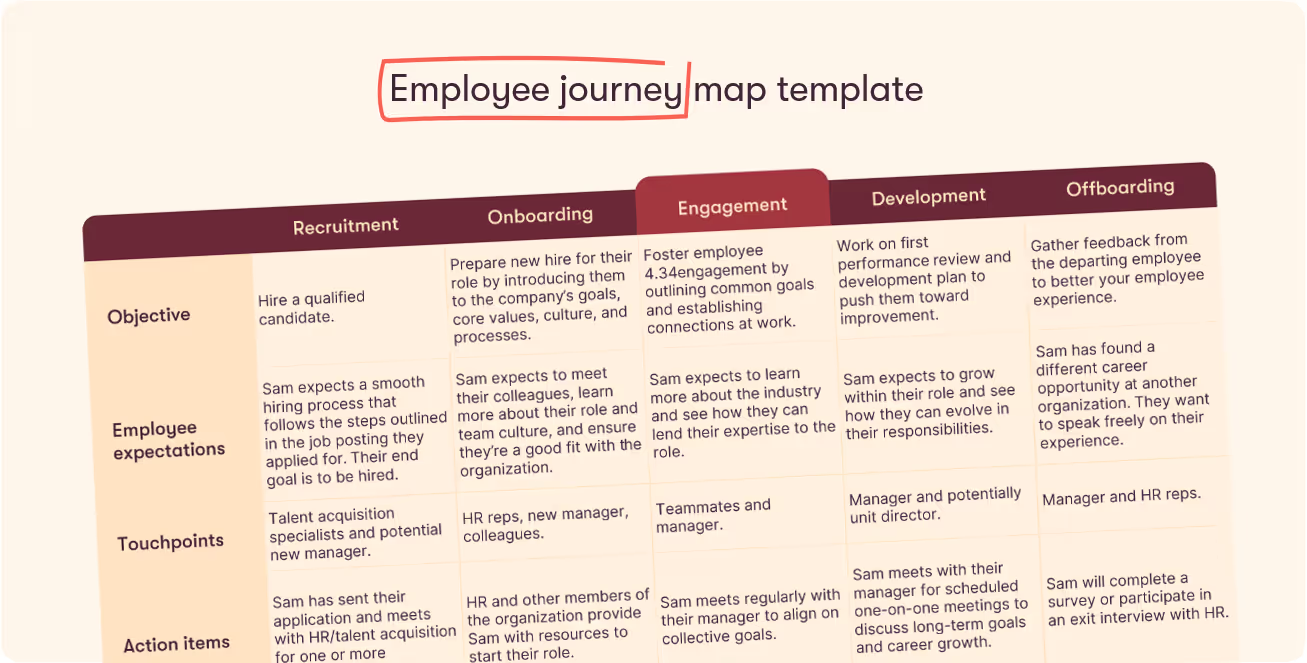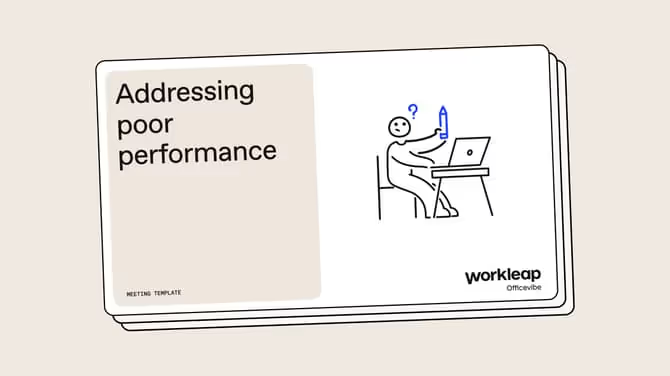How to map the employee experience journey (with an example and a template)

Discover Workleap Officevibe's benchmark report on 12 key employee engagement metrics

The customer experience is arguably one of the most important elements for a business to consider and nurture if they want to succeed within the landscape of modern work. While the customer journey cannot be overlooked, organizations must apply the same energy and resources into engaging their workforce if they want to thrive for years to come.
The concept of customer journey mapping is nothing new: you use the mapping process to identify customer pain points and improve upon them. Similarly, organizations can optimize their workforce by asking, what is employee journey mapping, and how does it improve the employee experience?
Employee journey maps allow you to identify critical moments during employee experiences that affect your people and business outcomes. By identifying key stages — from recruitment to exit interviews — companies can delve deeper into the employee lifecycle, address pain points, and enhance retention by fostering a better employee experience for all team members.
What is employee experience journey mapping?
The employee journey (also called the employee lifecycle) covers every interaction an individual has with their employer brand, from the first contact to the post-employment interview. Employee journeys differ greatly between businesses, industries, and departments. For example, a new intern with minimal experience beginning a sales role will have a different journey than a seasoned exec switching companies.
The employee journey typically involves the following stages:
- Recruitment: The recruitment stage includes application screenings, interviews, a job offer process, and contract negotiations.
- Onboarding: The onboarding process for new hires prepares them for their roles by introducing them to the company's goals, core values, company culture, and processes.
- Engagement: Employee engagement happens as new members join their team, connect with co-workers and managers, and become motivated by a common goal.
- Development: As new employees settle into their roles, the employee development phase includes the first performance review, performance management strategies, and initiatives aimed at continuous improvement.
- Offboarding: Current employees may be seeking other professional opportunities. If they've decided to leave, exit interviews and other wrap-ups should be performed in this phase.
An effective employee journey map offers a holistic view of an employee's journey, using simplified visualization to identify issues, plan career progression, and gain valuable insights into experiences at various touchpoints. To retain your top talent for the long haul, you can build an employee journey map to discover improvement areas in your employees' experience.
So, what does an employee journey map include? Utilizing an employee journey mapping template helps organize data related to critical touchpoints, employee stages, and broader focus areas. Typically, an employee journey map covers the following:
- An employee experience overview
- Employee personas with individual journeys
- Micro touchpoints for each employee persona
- General employee goals and objectives
- Improvement goals
- Employee feedback
- Improvement area insights
- Actionable strategies
The employee journey map should provide a holistic view, ensuring key moments are identified to foster a positive employee experience.
Steps to map the employee experience journey
1. Define goals for your employee journey maps
Before you begin employee journey mapping, you should align your team on the context and objectives of these conversations. What do you want to achieve, and why? Your employee journey mapping goals should be specific, actionable, and measurable so you can use data models to analyze results.
We recommend using a tool to define and track goals throughout the employee journey mapping process. For example, with Officevibe's goals and OKR tool, you can set overarching objectives and then determine realistic steps toward success, for easy progression tracking and better team alignment.
Here are a few goals your company could shoot for:
- Identify the root cause of high employee turnover
- Improve the onboarding experience
- Align other departments with HR initiatives
- Help new employees understand their role in company growth
- Drive revenue growth and increase market share
- Improve employee experience and satisfaction
- Focus on more positive experiences in remote work environments
- Improve employee loyalty and reduce turnover rates
These goals may sound like lofty concepts, though by pinpointing problem areas along the employee journey map, you can develop specific strategies that align with your organizational objectives.
2. Identify employee personas
You can create and use personas to dive into the employee’s perspective, better understanding their problems, desires, and goals. Personas include basic demographics and descriptive details like their personal background, life goals, primary skills, and biggest pain areas.
Identifying employee personas for all major groups within your company is key to understanding employees' experiences. Personas help you appreciate how your employees' journey stages and touchpoints vary. You may have a persona for each company department and skill level.
For comprehensive employee experience insights, you can include the following details with each persona:
- Name
- Job role
- Age range
- Education
- Years of experience
- Location
- Expected income
- Preferred technology
- Career goals
- General worries
- Frustrations with the company
- Skills
- Hobbies
3. Outline the employee journey stages
Now that you've explored the employee experience and understand who your team members are, you can begin outlining each stage of the journey to improve employee satisfaction and retention. Human resources should develop a separate employee journey map for each persona since their experiences will be unique. The employee journey map can include bigger-picture concepts, like their professional development or career objectives, the pain points they experience, and the phases they move through with the company.
Follow these steps to outline the employee journey stages:
- Define upper-level stages: While each persona will have a different employee journey, the upper-level stages will remain the same. Think about the main processes every employee must follow: hiring, onboarding, etc.
- Add details to each stage: The details within each stage are how you discover improvement areas. For example, for the hiring process, consider the initial contact, screening methods, the job interview, the offer process, etc.
- Map stages to persona goals: Now that you've created a detailed employee journey map template, you can tailor the information to each persona's goals and expectations. Map the data across each of your personas, contextualizing the details based on their personal needs, goals, and challenges.
- Locate problem areas: Once you see the employee journey map through the eyes of all your employees, you can see what issues they have. For example, an employee might be struggling to engage in their role after a few months due to a lack of team alignment.
- Develop solutions: After identifying specific challenges from your journey map, you can develop strategies and solutions. Using the previous example, your solution may be to incorporate more group meetings and collaboration tools to create better alignment with the team.
The above steps can seem overwhelming at first, but they offer resounding positive effects for your employees, teams, and for the overall health of your business. HR teams can benefit from using organizational tools to consolidate information, facilitating easier mapping and tracking. For example, you can use visual collaboration tools like Miro boards to create and repeat your journey map templates across each persona.
4. Gather feedback on the employee experience
Identifying problem areas by looking at a map will only get you so far. You need to learn from your employees which changes they'd like to see. Employee engagement surveys, along anonymous feedback channels, and one-on-one meetings, provide invaluable insights into the employee experience at each stage.
For example, you can use onboarding feedback surveys after training new employees to see how team members feel about that phase in their journey. With targeted questions, open-ended responses, and anonymous settings, you can discover minor pain points you may not have located on the map. For example, a few employees may respond that the software used for training is challenging and requires additional support — which is a fairly simple fix.
Gathering feedback at each stage of the employee journey allows you to measure the effectiveness of your improvement plans, leading to more engaged employees. By asking the right employee experience survey questions, you can get into the nitty-gritty details of each phase.
At Workleap, we simplify developing insightful and engaging custom employee surveys so you can take the guesswork out of your employee experience strategy.
5. Take action and measure results
Once you've gathered your feedback, it's time to put the pieces together and spring into action. Implement initiatives with realistic scopes and timelines to enhance the overall employee experience, addressing identified problem areas and aligning with organizational objectives. Set milestones and identify key metrics that you can incorporate into your employee experience template to help you measure your team's engagement.
6. Follow up on progress
While it's extremely important to keep tracking trends and fluctuations in your employee experience over time, it's vital to follow up on your initiatives so that you can see if they're worth the time and resources you've put into them. Following up on the progress of your initiatives also boosts transparency and keeps the members of your organization collectively accountable for fostering a better employer brand and improving the employee experience.
Example of an employee journey map
For this employee journey map example, we will use a persona called "Sam." You just hired Sam and they start on Monday. During the onboarding phase, their employee journey may look something like this:
- Objective: Prepare new hire for their role by introducing them to the company's goals, core values, culture, and processes.
- Employee expectations: Sam expects to meet their colleagues, learn more about their role and team culture, and ensure they're a good fit with the organization.
- Touchpoints: Sam will engage with their HR reps, new manager, and colleagues.
- Action items: HR and other members of the organization provide Sam with resources to start their role.
- Pain points/barriers: Sam may have to take in a lot of information in a short period of time, which may be overwhelming.
- Solutions: Sam can work with HR and their manager to organize the intake of information in a more realistic fashion.
- Follow-ups: HR will check in with Sam after their first week to ensure they have all the tools and resources to dive into their role.
You can answer any concerns and engage new employees by providing the right onboarding touchpoints, motivating content, and measuring tactics. Applications and tools like Workleap Onboarding help you build a more personalized onboarding experience and show your new hire that you're committed to their employee experience.
This process applies to all different phases of the employee journey, so analyze each in-depth. You can use this employee journey map template to learn more about the employee experience at your organization.

Build the best employee experience
Employee journey mapping is the best way to develop a successful employee experience strategy. By gathering feedback through targeted surveys, internal communications, and data analysis, you can improve each phase in the employee lifecycle and enhance workplace experiences.
Keep making the employee experience a priority at your organization with tools that make it easy to gather insightful employee feedback responses with customizable templates, anonymous surveys, goal alignment, meeting support, recognition tools, and more.
Give HR and managers the clarity, confidence, and connection to lead better every day.


%20(1).avif)


.avif)
.avif)




%20(1).avif)



.avif)